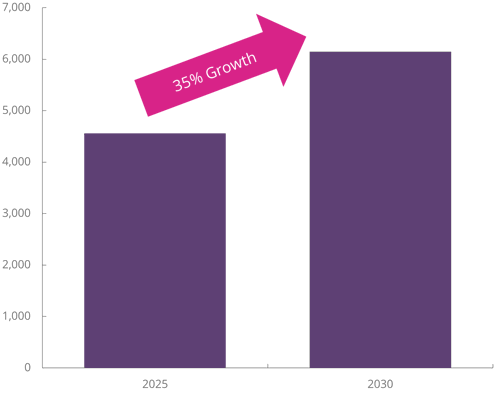Digital Identity Cards in the UK – Controversial, But Will They Work?
The UK Government has announced that it intends to introduce digital identity cards, held on people’s phones. The proposed 'Brit Card' would be a digital form of identification held in a UK government app and would be mandatory for certain uses, such as proving one’s right to work in the country.
Prime Minister Kier Starmer described the plans as follows: “Digital ID is an enormous opportunity for the UK. It will make it tougher to work illegally in this country, making our borders more secure. And it will also offer ordinary citizens countless benefits, like being able to prove your identity to access key services swiftly – rather than hunting around for an old utility bill.”
These plans will see the Brit Card become available to all UK citizens and legal residents in the UK by the end of the current Parliament, currently scheduled for August 2029, though the plans will require legislation and a public consultation.
Identity Cards in the UK – A Troubled Past, But Promising Future?
Any mention of the issuing of identity cards is a contentious one in the UK, with former Prime Minister Tony Blair’s government in the early 2000s proposing, under the Identity Cards Act 2006, and subsequently failing to roll-out a national identity card scheme.
While identity cards are mandatory, or at least offered, in a large number of countries, they have been controversial in the UK due to civil liberties concerns. The focus on using digital identity as a method to curb illegal working in the UK economy represents a different strategy from before, but it is still a highly debatable move.
However, if the political challenges can be navigated, there is high potential for such an approach. By providing cards free of charge and providing the ability to check right to work versus a government database, this would make right to work checks quicker and easier, and could potentially simplify enforcement. Outside of the immigration argument, there are numerous benefits to digital identity use – easier access to government services, the ability to seamlessly age verify during online and in-person transactions, and many others. The potential is there, but the path to making a success of digital identity in the UK will be challenging.
Initiative Must Learn the Lessons of Other Countries and the Past
In order to make a success of digital identity in the UK, the UK Government must learn from both technology failures in the UK as well as best practice from other markets. Learning from key examples, such as Norway’s BankID, Singapore’s SingPass, and India’s Aadhaar, is vital to success. A few key considerations are the following:
- Benefits must be clear - The benefits of the scheme, rather than the requirement to have a digital ID for legal reasons, should be communicated clearly, such as easy access to government services.
- Third-party support and interoperability are vital - The UK has a vibrant digital identity market, particularly in the verification space, so ensuring the market is included is important. Also, interoperability with existing identity elements, verification types, and international schemes would be desirable.
- Accessibility matters - While a large majority of users have the means to access online services, ensuring that vulnerable users - such as the elderly, disabled or the homeless - can still access systems is vitally important. Excluding users from accessing services they are entitled to, due to a lack of a smartphone or Internet access, would be extremely damaging.
- Consider fraud - When any digital service launches, considering the potential for fraud is vital. Ensuring that identities are verified when entering the system will be important to ensuring the stability of the system.
When considering other initiatives in flight, the EU’s eIDAS 2.0 initiative, which is creating a broad EU ID wallet system for roll-out in 2026, is an important scheme to consider. From a collaborative point of view, with the EU as the UK’s biggest neighbour, interoperability between systems would be desirable.
Taking the design of the EU system to heart is important too. eIDAS 2.0 places the citizen in control of their data: what is shared to whom and when, and so building the Brit Card with this citizen-permissioned philosophy will go a long way to securing buy-in for the scheme.
The UK Government should also consider the history of IT project overspends and failures in the UK public sector, such as the hugely costly National Programme for IT in the NHS, which was estimated to have cost £10 billion ($13.4 billion) when it was shelved in 2011. Ensuring that this kind of failure does not reoccur is important. The UK Government should ensure that its approach to digital identity remains focused and consistent, with a previous private-led approach to digital identity being disrupted by a public-led model.
Despite the many challenges involved, digital identity cards, overall, have strong potential. For this reason, our latest research points to a 35% growth in the number of people with digital identity cards between 2025 and 2030.
Number of People Globally With Digital Identity Cards (m) 2025 vs. 2030

Source: Juniper Research
Future Outlook
Clearly, the use of identity cards of any type in the UK will always be divisive, and whether the scheme actually comes into service is a matter for debate. However, despite the difficult challenges to navigate, there is strong potential for digital identity use.
Digital identity can empower citizens, provide them with streamlined access to services, and give them control over how their identity is used. As the UK Government moves forward with Brit Card, it must make a positive argument for how the scheme will empower citizens, and how civil liberties will be enshrined. If it fails to articulate a positive case with robust controls, adoption and usage of the system - if implemented - will struggle to gain traction.
Nick Maynard is VP of Fintech Market Research at Juniper Research, where he leads analysis on key trends shaping the future of finance. With deep expertise across digital payments and commerce, his recent work includes reports on Chargeback Management, Digital Commerce, and Payment Card Technologies; helping stakeholders stay ahead in a rapidly evolving market.
Latest research, whitepapers & press releases
-
 ReportDecember 2025
ReportDecember 2025AI Agents for Customer Experience Platforms Market: 2025-2030
Our comprehensive AI Agents for Customer Experience Platforms research suite comprises detailed assessment of a market that is set to disrupt mobile communications. It provides stakeholders with insight into the key opportunities within the AI agents for customer experience platforms market over the next two years.
VIEW -
 ReportDecember 2025Fintech & Payments
ReportDecember 2025Fintech & PaymentseCommerce Fraud Prevention Market: 2025-2030
Our eCommerce Fraud Prevention research suite provides a detailed and insightful analysis of this evolving market; enabling stakeholders from financial institutions, law enforcement agencies, regulatory bodies and technology vendors to understand future growth, key trends, and the competitive environment.
VIEW -
 ReportNovember 2025Telecoms & Connectivity
ReportNovember 2025Telecoms & ConnectivityeSIMs & iSIMs Market: 2025-2030
Juniper Research’s eSIMs and iSIMs research suite offers insightful analysis of a market set to experience significant growth in the next five years. The research suite provides mobile network operators (MNOs), original equipment manufacturers (OEMs), and eSIM management and platforms vendors with intelligence on how to capitalise on the market growth, and guidance on how eSIM-only devices and sensors, SGP.42, in-factory provisioning, and iSIMs will change the competitive landscape.
VIEW -
 ReportNovember 2025Fintech & Payments
ReportNovember 2025Fintech & PaymentsModern Card Issuing Platforms Market: 2025-2030
Our Modern Card Issuing Platforms Market research suite provides a detailed and insightful analysis of this evolving market; enabling stakeholders from banks, financial institutions, fintech companies, and technology vendors to understand future growth, key trends, and the competitive environment.
VIEW -
 ReportNovember 2025Fintech & Payments
ReportNovember 2025Fintech & PaymentsDigital Wallets Market: 2025-2030
Our digital wallets research suite provides detailed analysis of this rapidly changing market; allowing digital wallet providers to gain an understanding of key payment trends and challenges, potential growth opportunities, and the competitive environment.
VIEW -
 ReportOctober 2025Fintech & Payments
ReportOctober 2025Fintech & PaymentsDigital Identity Market: 2025-2030
Juniper Research’s Digital Identity research suite provides a comprehensive and insightful analysis of this market; enabling stakeholders, including digital identity platform providers, digital identity verification providers, government agencies, banks, and many others, to understand future growth, key trends, and the competitive environment.
VIEW
-
 WhitepaperDecember 2025Telecoms & Connectivity
WhitepaperDecember 2025Telecoms & ConnectivityHuman + AI: Drivers of Customer Experience AI Agents in 2026
Our complimentary whitepaper, Human + AI: Drivers of Customer Experience AI Agents in 2026, examines the key drivers of the AI agents for customer experience platforms market in 2025.
VIEW -
 WhitepaperDecember 2025Fintech & Payments
WhitepaperDecember 2025Fintech & PaymentsBeyond Chargebacks: The True Cost of Fraud for Digital Commerce
Our complimentary whitepaper, Beyond Chargebacks: The True Cost of Fraud for Digital Commerce, examines the state of the eCommerce fraud prevention market; considering the impact of evolving digital fraud strategies, including key trends such as identity theft, account takeovers, chargebacks, policy abuse and friendly fraud.
VIEW -
 WhitepaperNovember 2025Telecoms & Connectivity
WhitepaperNovember 2025Telecoms & ConnectivityeSIM-only Devices: The Impact on Operators, Consumers, and IoT
Our complimentary whitepaper, eSIM-only Devices: The Impact on Operators, Consumers, and IoT, explores the challenges and opportunities for the three segments, with a particular focus on eSIM-only smartphones and SGP.42.
VIEW -
 WhitepaperNovember 2025Fintech & Payments
WhitepaperNovember 2025Fintech & PaymentsUnlocking the Next Stage of Growth for Modern Card Issuing Platforms
This free whitepaper analyses key trends shaping the modern card issuing space, and the ways in which modern card issuing platforms can capture growth.
VIEW -
 WhitepaperNovember 2025Fintech & Payments
WhitepaperNovember 2025Fintech & PaymentsTop 10 Fintech & Payments Trends 2026
Fintech is evolving fast. From stablecoins to agentic AI, our annual guide reveals the shifts redefining payments, digital identity, and the future of money in 2026. Download your copy today.
VIEW -
 WhitepaperNovember 2025Fintech & Payments
WhitepaperNovember 2025Fintech & PaymentsDigital Wallets: Empowering Financial Inclusivity
Our complimentary whitepaper, Digital Wallets: Empowering Financial Inclusivity, examines the state of the digital wallets market; considering the impact of digital wallets on different geographies, how they are shaping the modern payments landscape through lower transaction fees and promoting financial inclusivity for underbanked populations, and how they are competing with established payment methods.
VIEW
-
IoT & Emerging Technology
Juniper Research Unveils Top 10 Emerging Tech Trends to Watch in 2026
January 2026 -
Fintech & Payments
Digital Identity App Usage to Hit 6.2 Billion by 2030, Driven by Shift to Decentralised Models
December 2025 -
Telecoms & Connectivity
Travel eSIM Margins Under Pressure as Revenue per Gigabyte Falls 10% Globally in Two Years
December 2025 -
Telecoms & Connectivity
AI Agents to Power 1,000% More Customer Interactions for Enterprises Globally by 2027
December 2025 -
IoT & Emerging Technology
Global D2C Revenue Set for $370 Million Surge, But Satellite Operators Should Not Chase Full MNO Status
December 2025 -
Fintech & Payments
Digital Goods Fraud to Cost eCommerce Merchants $27 Billion Globally by 2030 as AI Tools Accelerate Attacks
December 2025
























